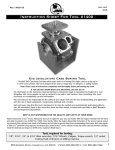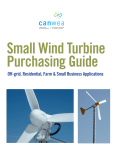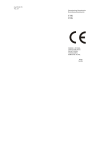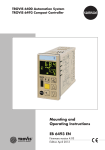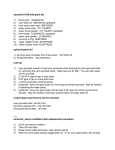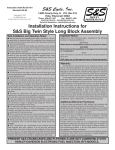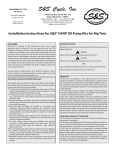Download Instruction Sheet For Tool #1177
Transcript
No.1177-IS Rev D 4/05 Instruction Sheet For Tool #1177 TWIN CAM “Alpha” & “Beta” Case Boring Tool The JIMS® Twin Cam Case Boring Tool takes all the guess work out of boring Twin Cam engine cases to accept JIMS® 4" bore cylinders, 100” big bore kit, and 113" and 116" flywheel stroker kits. Will also work on cylinders up 4.125” with stock cylinder stud pattern. This tool is designed to be used in a heavy-duty 15" drill press, or milling machine. Note: Please read all instructions completely and thoroughly before performing any work. IF YOU DO NOT KNOW WHAT YOU ARE DOING, DO NOT DO IT! None of the information in this instruction sheet pertaining to motorcycle repair is represented as fool-proof or even altogether safe. Some people can ruin a mechanic’s vise with a tack hammer. Even something safe, done incorrectly or incompletly can and will backfire. You and only you are responsible for the safety of your repair work and for your understanding and application with the use of repair equipment, components, methods and concepts. Each and every step that this tool is designed to do must be carefully and systematically performed safely by you. All ® information listed in this instruction sheet has been tested, re-tested and used daily in JIMS Research and Developement Department. JIMS® IS NOT RESPONSIBLE FOR THE QUALITY AND SAFETY OF YOUR WORK. Tools required for boring: 1/8”, 3/16", 1/4", & 5/16" Allen wrenches, 7/16” Wrench, Calipers, Torque wrench, 1/2" socket, Cutting Fluid, Drill press or Milling machine. Follow instructions in H-D® Service Manual for removal of engine for your year and model. With engine removed from frame and safely mounted in one of JIMS® Twin Cam motor stands (refer to JIMS® catalog for stands), follow the engine disassembly instructions in the service manual, including removing and installing cylinder studs. Mask off all bearings and oil holes to prevent chips from contaminating those areas. Bolt cases together with HD® hardware using sequence and torque specs stated in H-D® service manual, except top center case bolt between cylinders. Install this bolt last and torque to 50-90 in-lbs. maximum (Read Step 1). CAUTION: Wear safety glasses. Excessive force may damage parts! 555 Dawson Drive, Camarillo, CA 93012 Phone 805-482-6913 • Fax 805-482-7422 1 No.1177-IS Rev D 4/05 Instruction Sheet For Tool #1177 INSTRUCTIONS FOR 4” BORE 1A. 4” BORE INFORMATION BEFORE STARTING: Prior to boring your case, you must modify your top center 5/16” case bolt that is located between the spigot holes as shown in FIG. 3 (see arrow). You need to modify the 5/16” case bolt as shown in Fig. 1A for 4” bore. NOTE: Failure to do so will result in damage to the cutting tool. +/- .010 +/- .010 +/- .010 Fig.1A FOR 4 1/8” BORE 1B. 4-1/8” BORE INFORMATION BEFORE STARTING: Prior to boring your case you must decide on how to obtain the proper clearance for your top center case bolt as shown in Fig. 3. (See arrow). NOTE: Failure to do so will result in damage to the cutting tool. (1B) Option 1. You may use the stock case bolt and modify the case bolt diameter similar to the bolt shown in Fig. 1A. NOTE: Failure to do so will result in damage to the cutting tool. (1B) Option 2. You may use a 5/16” x 5” long stud or allen bolt with nuts and washers. You may drill a 5/16” hole through the right case with normal bolt clearance. You should spot face the right side case hole as shown in Fig. 1B to maintain flatness. You will need to provide more clearance for the 5/16” allen bolt or stud similar to 4” bore bolt as shown in Fig. 1A. NOTE: Failure to do so will result in damage to the cutting tool. Fig.1B Fig.1C (1B) Option 3. You may use a 1/4” x 5” long stud or an allen bolt, both with nuts and washers. Drill 1/4” hole with normal clearance through the right side of the case. You should spot face the hole as shown in Fig. 1B to maintain flatness. You will then need to check your allen or stud bolt for the proper clearance and it may need to be modified to be similar to the bolt as shown in Fig. 1A. NOTE: Failure to do so will result in damage to the cutting tool. 2. Assemble Engine Cradle (No.1, No.2 & No.3) with all nine 3/8” allen screws as shown in Fig.2. Torque the nine 3/8” allen screws to 10 ft. lbs. Make sure all mating surfaces are clean. Position Plate (No.3) with the appropriate lettering "A" for Alpha, "B" for Beta, facing outboard. NOTE: Lube all hardware with 20w50 H.D.® oil. 3. Place the Engine Case in the Cradle and rotate the case so either the Front or Rear cylinder deck is horizontal and facing up. Fig.3 4. Install (2) lubed 1/4-20 SHCS (No.10) into the holes marked with "F" or "R", depending on the spigot bore you are modifying, in the plate No.3 as shown in Fig.2. Do not tighten. Install (3) lubed 5/16-18 SHCS (No.13) into plate (No.1) holes marked with letter of the spigot bore you are modifying. Do not tighten. 5. Install lubed "T" Pin (No.14) into hole in (No.3), as shown in Fig.2 & Fig.4, marked "F" for Front or "R" for Rear depending on which spigot bore you are modifying. This will align the spigot bore perpendicularly to the machine spindle. You may need to rotate the case slightly to get the "T" Pin to locate properly in the hole. Using a 3/16” allen wrench, torque the 1/4-20 SHCS (No.10) to 90-120 in-lbs. and all 5/16-18 SHCS (No.9) to 13-15 ft-lbs using a 1/4” allen wrench. 6. INSTALLING CUTTERS: Note: Boring Head set-up shown is for reference only. Your set-up will vary depending on cylinder bore and cylinder manufacturer. Instruction sheet is written for boring clearance for 4” bore cylinders. Again, if your cylinders are from a different manufacturer or you are machining for other than a 4” bore, you will need to calculate your cutter dimensions (see set-up sheet on page 5). MODEL TYPE FACING OUT 14 3 10 13 22 2 9 11 11 9 1 Fig.2 Fig.3 CAUTION: Fig.4 Wear safety glasses. Excessive force may damage parts! 555 Dawson Drive, Camarillo, CA 93012 Phone 805-482-6913 • Fax 805-482-7422 2 No.1177-IS Rev D 4/05 Instruction Sheet For Tool #1177 20 NOTE: JIMS® recommends removing no more that .125” (on the diameter) of material at a time. Case machining may require more than one pass and more than one set-up of the cutters to obtain your desired bore. Failure to follow this could result in a ruff finish, and /or damage to the bore and cutters. 17 18 12 12 19 Once you have determineed the cutter dimensions, install the cutters in the boring head as shown in Fig. 5. Fig. 6, & Fig. 7. Using a 1/8” Allen wrench, adjust the adjustment screws (No. 1689) to set the cutters dimensions from your calculations (Fig. 7). Use a caliper for accurate measurements. Ensure that the cutters are held snug against the adjusting screws as the lock down screws are tightened. Torque the lock down screws (In order shown, Fig. 7) to 90 in./lbs, to secure the cutters in place. 6 17 7 4 15 WARNING: If cutters are set beyond O4.40, the cutters may come in contact with the I.D. of the locating plate (1177-5 [No.5]), voiding the warranty of 1177-5. 15 16 7. 21 8 9 9 5 Fig.5 Spigot Depth Note: If using other than JIMS® 4” cylinders add .03”.06" to the length of your cylinder spigot. This will be the depth you need to bore your cases to. (Example: If your spigot is 1.600" add .03”.06" and your bore depth will be 1.630" +.03/-.00). Rough Cut Side (.03” Step) Fig.6 Alignment Pin Note: On the bottom of the support plate (No.5) there are machined reliefs to clear the opposite cylinder’s alignment pin (Fig.8). In some motor cases the alignment pins are installed higher or lower, so you will need to check to make sure that they do not interfere with the mounting of the support plate (No.5) to the case. To check the alignment pin clearance, place the Boring Head Assembly on case with a 1-1/2" to 2" wood block between boring assembly plates to prevent the top plate from dropping, and or resulting in the cutter contacting your case (See Fig.9). Without tightening the two screws (No.1668), place a piece of paper between the neighboring cylinder’s alignment pin and the support plate. Once you have torqued the screws make sure that the paper moves freely between the alignment pin and the support plate. If the alignment pin is too high (the paper will not move) the pin can be installed deeper or removed. If the pin is damaged during removal it will need to be replaced. Failure to check the alignment pin clearance may result in the final spigot bore being out of center. Finish Cut Side Dimensions for 4” Bore 1st Using a 1/8” allen wrench and a 7/16” wrench, set the boring depth to 1.850 +.03/-.00 by adjusting the stop depth adjustment screw (No.18) on the Boring Assembly top plate as shown in Fig.5 & Fig.8, measured from the finish tool cutter to the bottom of the locating plate (No.5). nd 2nd 2 8. Finish Cut Side Rough Cut Side 2nd 1st st 21nd Tighten these screws first. 2nd Tighten these screws second. LOCK DOWN SCREWS 2 PLC No.1689 Fig.7 CAUTION: 9. Mount the Boring Assembly onto motor case with (2) lubed 3/8-16 SHCS (No.9) using cylinder alignment pins (HD® No.16595-99A) to locate assembly. Make sure the Boring Assembly is sitting flush on the motor case. Using a 5/16” allen wrench torque the mounting bolts to 18-20 ft-lbs. Place the Case Boring Fixture onto a drill press or milling machine table. Center shaft of Boring Head (No.4) in chuck or collet. Note: If using a chuck, be sure the chuck jaws locate on the flats on the boring head shaft. Tighten the chuck (or collet depending on machine being used), and remove the wood block. Clamp the base (No.2) to the drill press table using the provided holes if possible. If unable to use provided holes be sure to clamp the fixture using C-Clamps or comparable clamps. Before running machine, lube the two guide dowels with a light oil and run the quill up and down to make sure the Boring Assembly is not binding. Caution: When checking to make sure the tool action is correct, be aware not to strike the cutters against the crankcase while the Wear safety glasses. Excessive force may damage parts! 555 Dawson Drive, Camarillo, CA 93012 Phone 805-482-6913 • Fax 805-482-7422 3 No.1177-IS Rev D 4/05 Instruction Sheet For Tool #1177 Cylinder Dowel Reliefs Depth adjustment screw machine is not running. Damage may result to the tool and the crankcase. Note: If the base plate assembly is not sitting flat to the press table, adjust the table (or head) flat before clamping down the tool assembly. 10. Set the machine’s speed to approximately 600-800 RPM’s. Before running the machine, make sure the quill is at the top of its travel. Start the machine to make sure head or table are not vibrating. If no vibrations, the RPM’s can be increased. If vibrations occur RPM’s will need to be reduced. JIMS® has found that 600-800 RPM is best when using a drill press, although results may vary. Caution: Always wear safety glasses! 11. Start boring with a slow, even pressure while applying cutting fluid (Slower feed rate will yield a cleaner finish) until the Boring Assembly Stop bottoms out. Shut down the machine and wait until it comes to a complete stop. Slowly retract the boring assembly untill it clears the case. Replace the wood block, and remove the Boring Assembly from the case. Fig.8 Note: Place a 1-1/2" to 2" wood block between boring assembly plates to keep top plate from dropping. CAUTION: It is recommended that you use a well maintained and dependable machine for this type of work. If you use a drill press or milling machine that is not up to normal standards, you take the chance of damage to your work and/or injury to yourself. This is why we recommend you use a safe and well maintaned drill press or milling machine. Make sure your machine is in good working order before starting any project. ALWAYS WEAR SAFETY GLASSES OR OTHER FACE AND EYE PROTECTION SUCH AS FULL FACE SHIELD. 12. Remove (2) 1/4-20 SHCS (No.10), (3) 5/16-18 SHCS (No.13), and "T" Pin (No.14). Rotate case so opposite spigot bore is straight up and repeat steps 3-11. 13. Wash cases as needed to remove all chips. Fig.9 CAUTION: Be sure to remove any case material from the top center case bolt holes of both left and right cases that are not attached well enough to stay in place during motor operation. See Fig.10 and Fig.1C (Fig. 1C on page 2.) NOTE: This is mostly a judgment call as to how much material will be removed. DO NOT REMOVE ANY MORE MATERIAL THEN NEEDED FOR A SAFE RUNNING MOTOR. NOTE: When re-assembling cases, tighten case bolts to factory specs except top center case bolt between cylinders. Tighten this bolt last after you have cylinders and heads installed and torqued to H.D.® specs. Apply Hylomar, or equivalent, sealer to shoulder of top center case bolt and torque to 50-90 in-lbs. maximum on 1/4” or 5/16” center bolt stud. CAUTION: BEFORE RE-ASSEMBLY OF YOUR ENGINE MAKE SURE THE THE INSIDE OF THE CASE, SPIGOT BORE AND ALL INTERIOR AND EXTERIOR POCKETS AND HOLES ARE FREE FROM ANY CONTAMINANTS. STOP, DOUBLE CHECK AND THEN TRIPLE CHECK. YOU DO NOT WANT ANY CONTAMINANTS LEFT INSIDE. DOING SO CAN AND WILL CAUSE PREMATURE WEAR AND DAMAGE. Fig.10 CAUTION: JIMS® IS NOT RESPONSIBLE FOR YOUR WORK! SO PLEASE USE YOUR BEST JUDGEMENT AND ALWAYS DOUBLE AND EVEN TRIPLE CHECK YOUR WORK. DOING SO WILL HELP ENSURE A POSITIVE EXPERIENCE AND OUTCOME. Wear safety glasses. Excessive force may damage parts! 555 Dawson Drive, Camarillo, CA 93012 Phone 805-482-6913 • Fax 805-482-7422 4 No.1177-IS Rev D 4/05 Instruction Sheet For Tool #1177 SET-UP SHEET FOR 4” BORE “A” .385 FINISH U.S.A. ROUGH U.S.A. X R XX #1177-4 “T” “S” BORING HEAD DIAMETER BORING HEAD DIAMETER .320 “B” O3.45 O4.20 Step 1: Measure your cylinder spigot diameter. (S) and add .02”. Step 2: Measure the boring head diameter (T) as shown above. Subtract boring head diameter from answer obtained in step 1, this is your overall clearance (D). Step 3: Divide your overall clearance by 2. This is your “A” dimension. D = OVERALL CLEARANCE S = CYLINDER SPIGOT DIAMETER T = BORING HEAD DIAMETER C = CASE BORING DIAMETER Step 4: Subtract .065” from your “A” dimension. This is you “B” dimension. FORMULA Step 1: S + .02” =C Step 2: C - T =D Step 3: D / 2 =”A” Step 4: “A” - .065” = ”B” CAUTION: EXAMPLE 4.20”+.02”= 4.22” 4.22”-3.45”= .77” .77”/ 2= .385” .385”-.065”= .32” Wear safety glasses. Excessive force may damage parts! 555 Dawson Drive, Camarillo, CA 93012 Phone 805-482-6913 • Fax 805-482-7422 5 No.1177-IS Rev D 4/05 Instruction Sheet For Tool #1177 PARTS LIST NO. QTY 1 2 3 4 5 6 7 8 9 10 11 12 13 14 15 16 17 18 19 20 21 22 23 1 1 1 1 1 1 1 1 9 2 4 2 3 1 2 6 2 1 1 1 1 3 1 TITLE OR DESCRIPTION PART NUMBER MOUNTING PLATE BASE PLATE ALIGNMENT PLATE BORING HEAD, BORING ASSEMBLY LOCATING PLATE, BORING ASSEMBLY SUPPORT PLATE, BORING ASSEMBLY SHIELDED BEARING PULL OUT DOWEL 3/8-16 x 1” SHCS 1/4-20 x 1” SHCS DOWEL PIN, 1/4” x 3/4” BUSHING 5/16-18 x 1” SHCS T-PIN, O 3/8” SHANK TOOL BIT, AL, CEMENTED CARBIDE, 3/8” 1/4-28 x 1/2”, set screw WASHER, 1/4”, SAE 1/4-20 x 1-3/4” Set Screw 1/4-20 JAM NUT 1/4-20 x1/2”, BHCS DOWEL PIN, 1/2” x 3-1/2” 3/8” AN WASHER INSTRUCTION SHEET 1177-1 1177-2 1177-3 1177-4 1177-5* 1177-6 8149 1685 1686 2133 8093 1681 2405 1687 1688 ** 1689 1683 1679 1682 8090 1680 1265 1177-IS *1175-5 is not covered under warranty if locating plate displays cutter marks from improper adjustment. ** 1688 Non-serviceable wear item, no warranty. WARRANTY All JIMS® parts are guaranteed to the original purchaser to be free of manufacturing defects in material and workmanship for a period of six (6) months from the date of purchase. Merchandise that fails to conform to these conditions will be repaired or replaced at JIMS® option the parts are returned within the six (6) months warranty period or within ten (10) Days thereafter. In the event warranty service is required, the original purchaser must call or write JIMS® immediately with the problem. Some problems can be rectified by a telephone call and need no further course of action. A part suspected of being defected must not be replaced by a dealer without prior authorization by JIMS®. If it is deemed necessary for JIMS® to make an evaluation to determine whether the part is defective, it must be packaged properly to prevent further damage and be returned prepaid to JIMS® with a copy of the original invoice of purchase and a detailed letter outlining the nature of the problem, how the part was used and the circumstances at the time of failure. If after an evaluation has been made by JIMS® and the part was found to be defective, repair, replacement or credit will be granted. 1. 2. 3. 4. 5. ADDITIONAL WARRANTY PROVISIONS JIMS® shall have no obligation in the event a JIMS® part is modified by person or organization. JIMS® shall have no obligation if a JIMS® part becomes defective in whole or in part as a result of improper installation, improper maintenance, improper use, abnormal operation, or any other misuse or mistreatment of the part. JIMS® shall not be liable for any consequential or incidental damages resulting in the failure of a JIMS® part, the breach of any warranties, the failure to deliver, delay in delivery, delivery in nonconforming condition, or for any other breach of contract or duty between JIMS® and a customer. JIMS® parts are designed exclusively for use in Harley-Davidson® motorcycles. JIMS® shall have no warranty or liability obligation if JIMS® part is used in any other application. Any parts or tool replaced by JIMS® becomes the property of JIMS® and will not be returned under any circumstance. 555 Dawson Drive, Camarillo, CA 93012 Phone 805-482-6913 • Fax 805-482-7422 6






